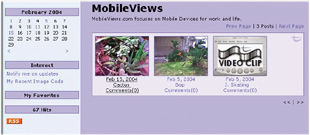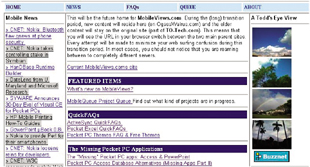Hack 83 Photo Moblogging
| < Day Day Up > |
| Camera phones have added a colorful new dimension to the text-heavy world of weblogging . With photo moblogging, you can publish pictures to the Web directly from your phone . If you want to share your latest cool camera-phone photo with a lot of people, you should investigate the world of photo moblogs . The word blog is a contraction of web log and refers to a linear, journal-like, informal text-entry system. A moblog is a mobile blog that allows entries to be made from a wireless mobile device, such as a wireless phone or PDA. Moblog content can be text, audio recordings, photographs, or even video. Figure 7-18 shows an example of a photo moblog. This hack will focus on moblogs that can handle photographs and videos . Perhaps we should call these kinds of moblogs multimedia blogs , or mublogs ? Figure 7-18. A Textamerica photo moblog Just as text-based blogs let you satisfy the urge to be a journalist or essayist, photo moblogs let you satisfy the urge to be a photojournalist or photo essayist. Photo-moblog web services let you send your camera-phone photographs directly to your own web site. You don't need to wait to get back to a desktop computer or buy an additional hardware peripheral. You will, however, need email service from your mobile-phone service provider. A growing number of photo-moblog sites offer free accounts:
New photo-moblog sites are appearing rapidly as the number of phone cameras continues to explode. This technology fad will probably take the same evolutionary path as other web fads and eventually see a consolidation of sites in the near future. So, make sure you keep an archive of your favorite camera-phone photos, just in case the photo moblog you use now disappears in the future. Most photo-moblog sites give you at least two ways to get your photo files from the camera phone to the site. The first method is the familiar web-browser interface that lets you copy files from your desktop computer to the web site. The mobile nature of moblogs leads to the second method, which you will probably want to use with your camera phone: emailing the photo directly from your camera phone to the moblog web site. Each photo-moblog service provides specific instructions on how to email a photo from your camera phone to that service. The general procedure is to email your photo to a special email address that the service assigns to you with an authorization password. You provide this password as part of the email address in the format AccountName.Password@DomainName.com. After emailing your photo to the photo-moblog site, it might take a few minutes (or longer) before the photo is viewable on your moblog page. The reliability of posting video files varies from service to service. After emailing a video to one moblog service, I found it took up to 12 hours for it to appear on one site. Another video-upload test to a different site did not work at all, but it didn't generate any error message either. Video uploads in the form of 3GPP video files should be considered experimental at this point, but you can expect to see video moblogging mature and stabilize in the near future. The ability to share your camera-phone photos does not end with the web pages provided to you by the moblog service. Some services provide RSS or some other XML-based syndication feature. For example, in Figure 7-19, I've used Buzznet to syndicate my camera-phone photos to a personal web site. Figure 7-19. Syndicated camera-phone photos on a personal web site Regardless of how this technology evolves, the ability to publish photos and video directly from your phone to a web site provides tremendous opportunity for keeping friends , family, and the world at large up-to-date on the world you see before your eyes. Todd Ogasawara |
| < Day Day Up > |
EAN: 2147483647
Pages: 161